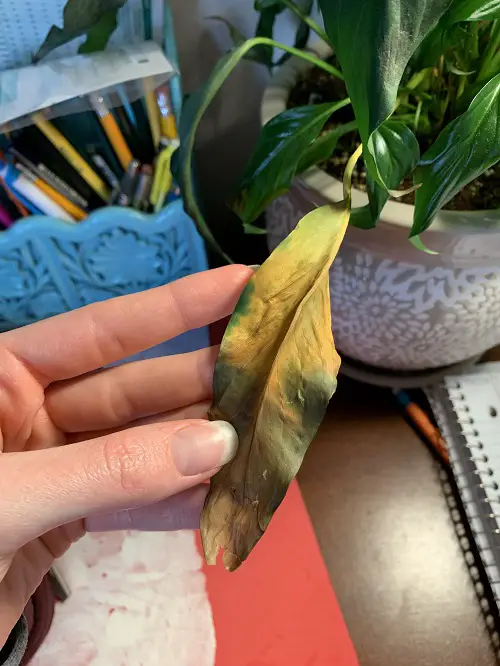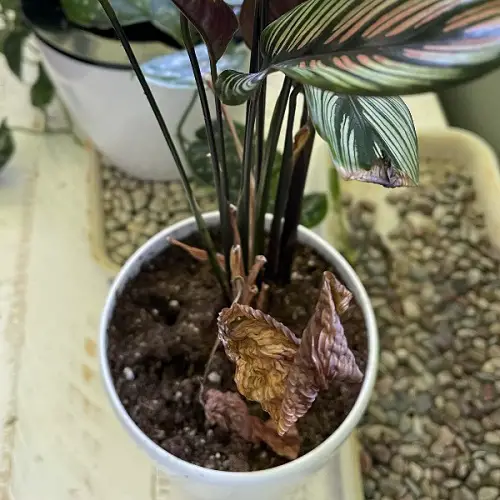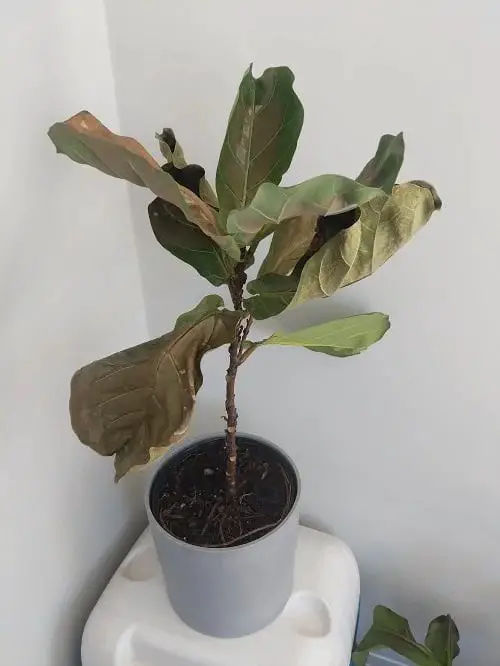Worried about your Indoor Plant Leaves Turning Black? Here are all the reasons and solutions to keep your plants safe!
Are your Indoor Plant Leaves Turning Black? It’s a sight that can dampen the beauty of your green oasis. But fear not! There’s a solution. Here are the reasons behind this phenomenon and simple yet effective solutions to bring your plants back to life!
Indoor Plant Leaves Turning Black? Reasons and Solutions
# 1 Reason: Overwatering

Overwatering is one of the most common causes of indoor plant leaves turning black. When plants receive too much water, the soil becomes waterlogged, leading to poor oxygen circulation and root rot.
The excess moisture creates an ideal environment for fungal growth, which can cause blackening of the leaves.
Solution: Water the plants only when the topsoil feels a little dry to the touch. Do not moisten the soil daly. Additionally, ensure that your plant’s pot has proper drainage holes to allow excess water to escape. Consider using a well-draining potting mix that allows water to flow through easily.
Here are Signs of Overwatering & How to Save an Overwatered Plant
# 2 Reason: Underwatering
Another reason behind indoor plant leaves turning black is under watering. When plants don’t receive enough water, they can become dehydrated, resulting in dry and withered leaves. As the leaves lose moisture, they may turn black or brown.
Solution: To prevent underwatering, regularly check the moisture level of the soil. Water your plant thoroughly when the top inch of the soil feels dry. Ensure that water reaches the roots by watering until it drains out from the bottom of the pot. However, be cautious not to let your plant sit in standing water, as it can lead to root rot.
Look out for these 5 Sure Shot Signs of Underwatered Plants
# 3 Reason: Lack of Humidity

Plants naturally transpire, which is the process of losing moisture through their leaves. When the surrounding air is dry and lacks humidity, the rate of transpiration increases.
This can cause the plant to lose moisture faster than it can absorb from the roots, leading to water stress. As a result, the leaves may wilt, turn brown, and eventually blacken.
Solution: To increase humidity, you can mist the leaves of your plants regularly with water, place a tray of water near the plants to allow evaporation or use a humidifier in the room. Grouping plants together can also create a microclimate of higher humidity among them.
Here are 10 Ways To Increase Humidity For Houseplants That Work
# 4 Reason: Nutrient Deficiencies
The next reason behind indoor plant leaves turning black is nutrient deficiencies. When a plant lacks essential nutrients, it struggles to carry out vital metabolic processes, which can lead to various symptoms, including leaf blackening.
Iron is crucial for chlorophyll production, and its deficiency can lead to chlorosis, where leaves turn yellow or pale. In severe cases, the chlorotic areas can progress to blackening, particularly along the leaf veins.
Zinc is necessary for various enzymatic activities in plants. Its deficiency can cause interveinal chlorosis, similar to manganese deficiency. Over time, the affected areas can darken and develop black or brown necrotic spots.
Solution: Use a balanced fertilizer specifically formulated for indoor plants and follow the recommended dosage. If you suspect a nutrient deficiency, consider testing the soil to determine the nutrient levels and make appropriate adjustments.
Find plant deficiency symptoms here
# 5 Reason: Too Much Fertilizer
Fertilizers contain salts, which, when applied excessively, can accumulate in the soil over time. As the concentration of salts increases, it can hinder the plant’s ability to take up water effectively. This creates a water imbalance within the plant, leading to water stress and subsequent leaf blackening.
Fertilizers are typically concentrated sources of nutrients. When overapplied, the high concentration of nutrients can burn the plant’s delicate root system. The damaged roots are unable to take up water and nutrients properly, resulting in leaf blackening and wilting.
Solution: Water the plant thoroughly to flush out the excess salts. Remove any damaged leaves and limit fertilization to 2-3 times per season. Consider repotting the plant in fresh soil if necessary.
Here are Effective Homemade Lawn Fertilizers That Are Safe From Hazardous Chemicals
# 6 Reason: Fungal Damage
Another reason behind indoor plant leaves turning black is fungal pathogens that can cause leaf spot diseases, where circular or irregular spots appear on the leaves. These spots can range in color, including brown, black, or dark lesions.
Anthracnose is a fungal disease that commonly affects various plants, causing dark, sunken lesions on leaves, stems, and fruits. As the disease advances, the lesions can turn black and become more extensive, leading to leaf death and defoliation.
Sooty mold is a type of fungal growth that develops on the surface of leaves, stems, or other plant parts. It appears as a black, powdery coating, often covering the entire leaf surface.
Solution: Remove affected leaves, enhance airflow around the plant, and apply a suitable fungicide. You should be mindful of watering practices to avoid creating conditions favorable for fungal diseases.
Here is How to Kill Plant Fungus with Baking Soda
# 7 Reason: Lack of Phosphorus

A lack of phosphorus in plants typically does not cause the leaves to turn black. Phosphorus deficiency primarily affects other aspects of plant growth and development rather than leaf coloration.
However, severe nutrient imbalances or multiple nutrient deficiencies can contribute to overall stress and lead to leaf discoloration, including blackening.
Solution: Check the soil pH and add garden lime if it is below 5 to neutralize acidity. Apply a phosphorus fertilizer as per the package instructions to address the deficiency.
Learn How to Check Your Soil pH at Home here
# 8 Reason: Frost Exposure

Solution: Protect plants from late frosts by covering them. You should avoid placing houseplants near cooling devices to prevent frost damage. Bring sensitive plants indoors before the frost hits your area.
# 9 Reason: Sunburn
Along with intense sunlight, high temperatures can exacerbate the effects of sunburn. The combination of intense light and heat can lead to the development of blackened or scorched areas on the leaves.
Solution: Provide shade or move the plant to a more shaded location. If you keep it near a window that receives direct sunlight, you should definitely keep it somewhere shady. Ensure adequate watering and gradually acclimate the plant to increased sunlight to prevent sunburn.
Here is How to Save Sunburned Plants
# 10 Reason: Pest Infestation

Certain sap-sucking insects, such as aphids, whiteflies, and scales, pierce the plant’s leaf tissues to extract sap. During this feeding process, they inject saliva into the leaves, which can lead to the formation of a sticky substance called honeydew.
Honeydew serves as a feeding ground for sooty mold fungi, which can grow on the leaf surface, causing a black, powdery coating.
Solution: Remove these pests by washing the plant with water and applying a horticultural oil spray. Address the fungal issues by removing sticky secretions and using a broad-spectrum fungicide to control the disease.
Click here to learn the Amazing Natural Pesticide Recipe that can Kill any Pest
#11 Reason: Root Rot

When roots are damaged or infected by fungi, usually due to excessive moisture and poor drainage, they become weakened and unable to absorb water and nutrients effectively. This leads to nutrient deficiencies, particularly in essential minerals like iron, which can result in chlorosis, where leaves turn yellow, black, or pale.
As the root rot progresses, the lack of oxygen and the accumulation of toxins in the root zone further impair the plant’s nutrient uptake and metabolic processes. The leaves start exhibiting signs of stress, including wilting, yellowing, and eventual blackening.
Additionally, root rot weakens the plant’s defenses, making it more susceptible to secondary infections by opportunistic pathogens, contributing to leaf blackening.
Solution: One of the primary causes of root rot is overwatering. Ensure you water your plants appropriately by allowing the top layer of soil to dry out before watering again. Use a well-draining potting mix specifically formulated for the types of plants you are growing. Ensure your plant containers have drainage holes to facilitate the flow of excess water out of the pot.
Here is How to Treat Root Rot in Houseplants Like a Pro
Watch this video for more information








